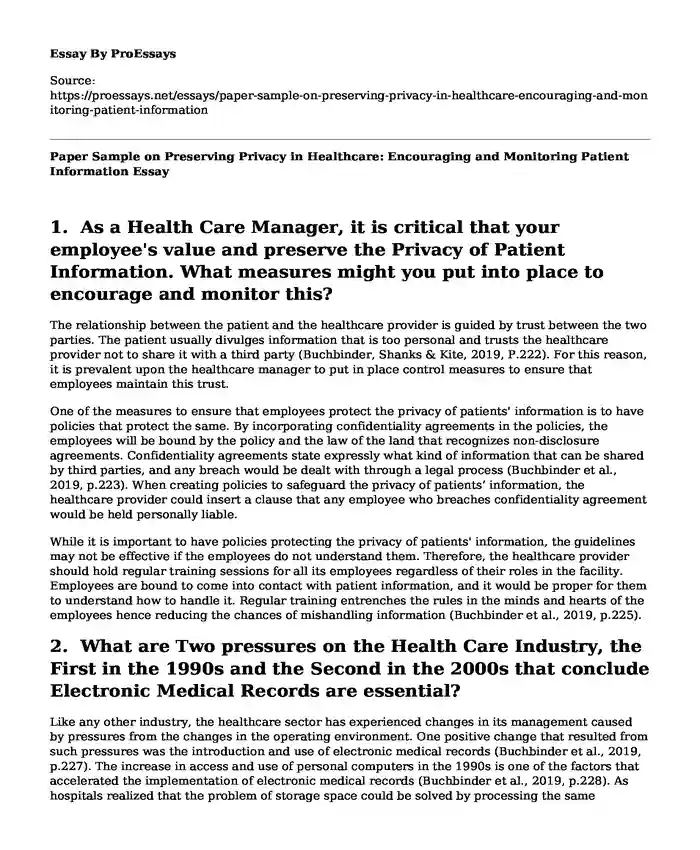1. As a Health Care Manager, it is critical that your employee's value and preserve the Privacy of Patient Information. What measures might you put into place to encourage and monitor this?
The relationship between the patient and the healthcare provider is guided by trust between the two parties. The patient usually divulges information that is too personal and trusts the healthcare provider not to share it with a third party (Buchbinder, Shanks & Kite, 2019, P.222). For this reason, it is prevalent upon the healthcare manager to put in place control measures to ensure that employees maintain this trust.
One of the measures to ensure that employees protect the privacy of patients' information is to have policies that protect the same. By incorporating confidentiality agreements in the policies, the employees will be bound by the policy and the law of the land that recognizes non-disclosure agreements. Confidentiality agreements state expressly what kind of information that can be shared by third parties, and any breach would be dealt with through a legal process (Buchbinder et al., 2019, p.223). When creating policies to safeguard the privacy of patients’ information, the healthcare provider could insert a clause that any employee who breaches confidentiality agreement would be held personally liable.
While it is important to have policies protecting the privacy of patients' information, the guidelines may not be effective if the employees do not understand them. Therefore, the healthcare provider should hold regular training sessions for all its employees regardless of their roles in the facility. Employees are bound to come into contact with patient information, and it would be proper for them to understand how to handle it. Regular training entrenches the rules in the minds and hearts of the employees hence reducing the chances of mishandling information (Buchbinder et al., 2019, p.225).
2. What are Two pressures on the Health Care Industry, the First in the 1990s and the Second in the 2000s that conclude Electronic Medical Records are essential?
Like any other industry, the healthcare sector has experienced changes in its management caused by pressures from the changes in the operating environment. One positive change that resulted from such pressures was the introduction and use of electronic medical records (Buchbinder et al., 2019, p.227). The increase in access and use of personal computers in the 1990s is one of the factors that accelerated the implementation of electronic medical records (Buchbinder et al., 2019, p.228). As hospitals realized that the problem of storage space could be solved by processing the same information on a computer processor, healthcare facilities started to invest in desktop computers which proved to be cheaper in the long term as compared to constructing physical storage facilities (Buchbinder et al., 2019, p.230).
In the 2000s, there was more pressure on the healthcare industry that further pushed for the adoption of electronic medical records. The signing of the Health Information Technology for Economic and Clinical Health Act (HITECH) in 2009 introduced the commercial value of HER. The law pushed for common functionality if various HER systems (Buchbinder et al., 2019, p.234). The law was perhaps a reprieve for health insurance providers who could verify their prospective clients' health records. Before the law was enacted, the insurance providers had difficulties collating information from various healthcare facilities to establish premiums (Buchbinder et al., 2019, p.237). Due to this, health insurance was expensive, considering the risk of not having accurate health information about prospective clients.
3. Where would you find examples of "Some Numbers" to help focus your search?
The healthcare industry is not limited to healthcare facilities, but it spans across other institutions such as government regulatory bodies and insurance providers. As such, research touching on health issues would rely on numbers from various institutions. One of the sources of such information is the National Library of Medicine, which has a repository for all clinical trials using human volunteers (Buchbinder et al., 2019, p.249). The health insurance providers could also provide valuable information, especially on the cost of healthcare in a particular jurisdiction.
Reference
Buchbinder, S. B., Shanks, N. H., & Kite, B. J. (2019). Introduction to health care management. Jones & Bartlett Learning. http://samples.jbpub.com/9781284081015/FrontMatter.pdf
Cite this page
Paper Sample on Preserving Privacy in Healthcare: Encouraging and Monitoring Patient Information. (2023, Sep 17). Retrieved from https://proessays.net/essays/paper-sample-on-preserving-privacy-in-healthcare-encouraging-and-monitoring-patient-information
If you are the original author of this essay and no longer wish to have it published on the ProEssays website, please click below to request its removal:
- Organization Structure and Life Circle - Research Paper on Management
- Research Paper on Social and Organizational Issues in Healthcare
- Managing the Impacts of Change Paper Example
- Essay Example on Medicare: Caring for America's Elderly for 50+ Years
- The Opioid Crisis in America
- Hippocampal Neurogenesis: Regulation of Cognitive & Psychiatric Diseases - Essay Sample
- Julie Thomas: Anxiety, Heart Attack Risk & Life Disruption - Case Study







